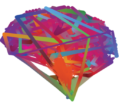Piece of Mind is a multidisciplinary collective of neuroscientists, musicians, dancers and circus artists collaborating with the goal of presenting scientific concepts through performance arts. The majority of scientific advances are only communicated in writing, and remain within the academic realm. While art-science projects have been picking up steam as a means of engaging the public in scientific research, these collaborations are primarily within the visual arts. Dance (and other performance arts) adds the unique element of movement, and is thus a powerful tool for illustrating abstract concepts or complex mechanisms which are difficult to depict in diagrams and text.
Our first project aims to explore 3 neurological disorders that affect movement: Parkinson’s disease (PD), Multiple Sclerosis (MS) and Amyotrophic Lateral Sclerosis (ALS). We will create an original piece of music for each, incorporating various elements of the disorder, and use this as a basis for creating a corresponding choreography. To represent the different scales at which we can study a neurological condition, we have divided our piece into 3 levels:
1. Genetic level. One of the most fundamental parts of neuroscientific research is identifying the genetic risk factors for neurological disorders. PD, MS and ALS all have known genetic mutations associated with them, which present as deletions, additions, or substitutions in a segment of DNA. To represent this level of research, we have composed a “baseline” melody (representing a DNA sequence) to which we then apply “mutations” based on the genetic mutations linked to each disorder, resulting in 3 different variations on the same melody. We are using this to create a choreography that follows the baseline melody, and changes based on each variation, resulting in a parallel representation of the 3 disorders.
2. Neurological level. Genetic mutations associated with neurological disorders, in combination with environmental factors, perturb the normal functioning of neurons and other cell types. This is primarily through altering proteins within the brain that control the development, communication and survival of neurons. To represent the neurological level of these disorders, we will create a unique piece of music for each one, incorporating elements of the physiological changes that take place. For instance, PD is marked by the progressive loss of dopamine neurons, which can be represented as a note / movement that is present at the beginning of the musical piece / dance, and diminished throughout. Altered signalling pathways and synaptic transmission can also be visually represented as by changing interactions between dancers. The choreographies for each piece will include multiple dancers, so as to represent increased complexity at this level.
3. Human Level. At this level, we would like to learn from and integrate and the lived experience of individuals with PD, MS and ALS. We will host workshops with the corresponding communities (led by community members working with movement disorders and dance therapy) to create the choreography for each disorder, and offer a chance to the affected individuals to share their experiences on stage. The music for each disorder will be based on the music from Part 1 and 2, but will add lyrics (spoken word, personal stories, testimonials, etc.) and other elements to represent the human condition.
The goals of this project are to use performance art to bring neuroscientific research to the public, foster relationships between neuroscientists and the communities affected by their research, and explore how science can be used as fuel for artistic creation.
This initiative is open to all skill levels and backgrounds. Individuals researching or directly affected by these diseases, as well as musicians, dancers and other performers are welcome to join in the content creation and/or performance of the piece . If you are interested in getting involved in this project or joining the group for future collaborations, please contact: Naila Kuhlmann (naila.kuhlmann@gmail.com) directly.
